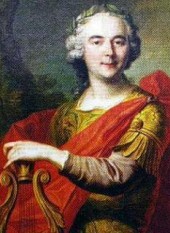Jean-Philippe Rameau
Type:
Artist / Band / Musician
Jean-Philippe Rameau (September 25, 1683 - September 12, 1764) was one of the most important French composers and music theorists of the Baroque era. He replaced Jean-Baptiste Lully as the dominant composer of French opera, and was attacked by those who preferred Lully's style.
LIFE and WORK
Rameau's father was the organist at the cathedral of Dijon, and had his son practicing harpsichord at the earliest age possible. However, Rameau began his studies in the field of law before deciding that the study and composition of music was his true passion. He spent much of his youth in Italy and Paris, and for a time followed his father's footsteps as organist at Clermont Cathedral. Rameau was perhaps most well known for his theories regarding tonality through basses fondamentales or root notes, the idea that chords remain equivalent under inversion, described in Trait de l'harmonie (1722) and Nouveau systme de musique thorique (1726). In 1722 Rameau relocated to Paris where he published many harpsichord collections as well as his Trait de l'harmonie (which was completed before his move to Paris). It wasn't until he reached his 40s that Rameau achieved prominence in the field of composition, but by the death of Franois Couperin in 1733 he was arguably the leading French composer of the time. From then on he devoted himself primarily to opera, starting with Hippolyte et Aricie (1733). He collaborated with Voltaire on a number of operas, in particular La Princesse de Navarre which earned him the King's title of "Compositeur de la Musique de la Chambre". At the end of his life Rameau also became a character in Denis Diderot's - then unpublished - dialogue Le neveu de Rameau (Rameau's Nephew). Even if he never composed a real symphony, he especially showed his skills in the operatic genre as an innovator of orchestral music and orchestration, influencing and anticipating the music of the Classical music era, Romantic music (Hector Berlioz), and even Stravinsky's neoclassicism in a short prelude in his last opera, Les Borades (1763). Brahms uses the theme of one of Rameau's pieces, "The Birds", as a subject for one of his chamber works.
His music was admired by two other great French composers; Hector Berlioz, who described Rameau's art as "one of the most sublime conceptions of dramatic music". The other was Claude Debussy, who was especially impressed by Rameau's opera Castor et Pollux (1737), which was revived in 1903: "Gluck's genius was deeply rooted in Rameau's works. (.) a detailed comparison allows us to affirm that Gluck could replace Rameau on the French stage only by assimilating the latter's beautiful works and making them his own." Camille Saint-Sans, Vincent d'Indy, and Paul Dukas were three other important French musicians who gave practical championship to Rameau's music in their day.
Instrumental works
Pices de clavecin. Trois livres. "Pieces for harpsichord", 3 books, published 1706, 1724, 1728.
Pices de clavecin en concerts Five albums of character pieces for harpsichord and harmony. (1741)
La Dauphine for harpsichord. (1747)
Several orchestral dance suites extracted from his operas.
Cantatas
Les amants trahis
Limpatience
Aquilon et Orithie
Orphe
Thtis (1727)
Le berger fidle (1728)
Motets
Deus noster refugium (before 1716)
In convertendo (c.1718)
Quam dilecta (1720)
Laboravi
Operas
Tragdies en musique
Hippolyte et Aricie (1733; revised 1742)
Castor et Pollux (1737; revised 1754)
Dardanus (1739; revised 1744 and 1760)
Zoroastre (1749; revised 1756)
Les Borades (unperformed; in rehearsal 1763)
Opra-ballets
Les Indes galantes (1735; revised 1736)
Les ftes d'Hb or les Talens Lyriques (1739)
Les ftes de Polymnie (1745)
Le temple de la gloire (1745; revised 1746)
Les ftes de l'Hymen et de l'Amour (1747)
Les surprises de l'Amour (1748; revised 1757)
Pastorales hroques
Zas (1748)
Nas (1749)
Acante et Cphise (1751)
Daphnis et Egl (1753)
Comdies lyriques
Plate (1745)
Les Paladins (1760)
Comdie-ballet
La Princesse de Navarre (1744)
Actes de ballet
Les Ftes de Ramire (1745)
Pigmalion (1748)
La Guirlande (1751)
Les sibarites (1753)
La naissance d'Osiris (1754)
Anacron (1754)
Anacron (completely different work from the above, 1757)
Nle et Myrthis (date unknown)
Zphire (date unknown)
Io (unfinished, date unknown)
Lost works
Samson (tragdie en musique)
Linus (tragdie en musique)
Lysis et Dlie (pastorale)
Writings
Trait de lharmonie rduite ses principes naturels (Paris 1722)
Dmonstration du principe de l'harmonie (Paris 1750)
Platée - Acte 3 Entr'acte
More RAMEAU Videos
Copyright © BANDMINE // All Right Reserved
